 Nuclear-powered ballistic missile submarines (built 1963-64), service 1964-1994: James Madison, Tecumseh, Daniel Boone, John C. Calhoun, Ulysses S. Grant, Von Steuben, Casimir Pulaski, Stonewall Jackson, Sam Rayburn, Nathanael Greene (SSBN-627 -636).
Nuclear-powered ballistic missile submarines (built 1963-64), service 1964-1994: James Madison, Tecumseh, Daniel Boone, John C. Calhoun, Ulysses S. Grant, Von Steuben, Casimir Pulaski, Stonewall Jackson, Sam Rayburn, Nathanael Greene (SSBN-627 -636).Cold War US Subs
GUPPY | Barracuda class | Tang class | USS Darter | T1 class | X1 class | USS Albacore | Barbel classUSS Nautilus | USS Seawolf | Migraine class | Sailfish class | Triton class | Skate class | USS Tullibee | Skipjack class | Permit class | Sturgeon class | Los Angeles class | Seawolf class | Virginia class
Fleet Snorkel SSGs | Grayback class | USS Halibut | Georges Washington class | Ethan Allen class | Lafayette class | James Madison class | Benjamin Franklin class | Ohio class | Colombia class
The James Madison class SSBN were a near-repeat of the Lafayette class which themselves evolved from the Ethan Allen class. The Lafayette, James Madison, and Benjamin Franklin classes, all very close, made the most important contribution of the “41 for Freedom,” the US nuclear deterrent force in late 1980s until planned replacement by the much larger, less numerous Ohio class. The James Madison group are considered by many authors as a Lafayette sub-class due to the changes made in the ballistic tubes to receive larger missiles in the future. Indeed, they gradually went from the Polaris A3 from the start (A2 for the Lafayettes), to the Poseidon and eventually the Trident I in 1980. Specifics and design changes were not many however. #ussjamesmadison #usnavy #unitedsttesnavy #ssbn #strategicsubmarines #usdeterrence #poseidon #trident #coldwar
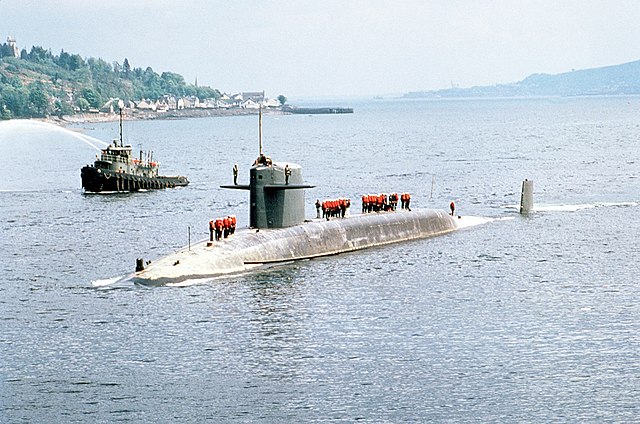
USS John C Calhoun
Second of the Lafayette SSBN superclass
The Lafayette class inaugurated a more mature design and a whole lineage compared to the Ethan Allen, a platform that will stay relevant with a large number of submarines until USS Will Rogers (SSBN-659) was completed at General Dynamics Electric Boat, on 1st April 1967. The first, USS Lafayette, was laid down in 1958. So they were built for almost a decade, and another decade passed for any new SSBN being laid down. This was to leave ample room to study the game-changing Ohio class, with the first boat, SSBN-660, being laid down in April 1976. The Naval rogram was indeed hit by post-Vietnam budget restriction and reevaluation of the submarine deterrence in general, and the Ohio enabled to replace at least two boats at once while bringing more warheard atr greater distances, and effectively to strike any point of the globe almost from home waters.
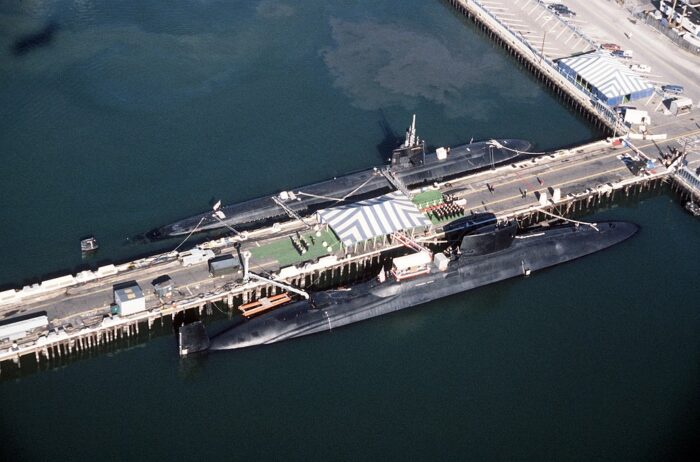
The Lafayette superclass comprised a total of 31 submarines and so made the bulk of the US ballistic deterrence force, the famous “41 for freedom”. This ensured that even if the majority were found and killed by Soviet SSNs, enough would be still around to ensure a devastating second strike. The Madison class, like the Lafayettes, were part of the Polaris programme, but the latter were designed to carry the Polaris A3 from the start, not the A2 which had severe range limitations. The Lafayette were converted to the A3 as soon as available but Madison (and Franklin class) were designed for it from the start, with deeper wells and sightly larger silos. The Madisons also evolved alongside the contemporary Sturgeon “superclass”, a good match between numerous SSBNs and their numerous SSNs escorts, 37 Sturgeon class boats, 31 Lafayette superclass boats.
The Los Angeles preceded the Ohio class but themselves were much larger and a good pair for the 1970s, a complete rethinking of characteristics and arguably 3rd generation in a post-Vietnam context.
Development of the Madison class
piccc
The first Lafayettes were essentially a follow-up of the Ethan Allens, with Polaris A-2 but with a stretched and reworked hull, which “hump” containing the missile silos being more generous, reshaped and made more rational, in order to enavle larger tubes and enable future upgrades. The forerunner of the Madison class was the last Lafayette, USS Daniel Webster, which had the A-3 silos from the start and tested the “minin sail” (see the previous article). The silo design was refined and integrated into the Madison class, making a better fit to fire later the Poseidon C3 ballistic missile. This helped keeping the class relevant and indeed bot the Madisons and Franklin had a long career compared to the Lafayettes, which could not operate the next Trident I. All classes had the same hovering system to better manage trim when firing missiles and enabling to fire four missiles per minute.
Design of the James Madison class
Hull and general design
The Lafayette/Madison/franklin class were a stretched version of the Ethan Allen, with an extra section for larger missiles tubes as well as improving maintenance and having better crew accomodations. Compared to the Ethan Allen, 410 ft 4 in (125.07 m), they reached 425 ft (130 m) for 8,251 long tons (8,383 t) submerged versus 7,884t. The Beam was slightly narrowed also to regain speed at 33 ft (10 m) and draft down to 28 ft 6 in (8.69 m) versus 29 ft 10 in (9.09 m). Being more nimble they were faster on paper despite the added weight and lenght, but less agile. Proportions were still the same, with identical ratios from bow to fin, a bit taller, and between the end of the “hump” forward to the tail. Their vertical tail was taller to regain agility. Dive planes were still on the sail but reshaped. Main water ingress scoops were located inside a “trench” running below the hump amidship but the details of the outer hull were refined even further compared to the Lafayette.
Powerplant
The Madison class had the exact same powerplant as on the Lafayette or Ethan Allen class, the rock-solid S5W PWR (Pressurized Water Reactor, 5 by Westinghouse (hence the “W”)). The Madisons also had same geared steam turbines, rated for 15,000 shp (11,000 kW), on a single shaft with the same 7-bladed hooked propeller. Top speed was 16 knots (30 km/h) surfaced, 21 knots (39 km/h) submerged. Test depth was 1,300 feet (400 m).
Armament
Initially they were designed for the Polaris A3 and thus the tubes were mlade larger. However they were built faster than development of the new missiles and thus, operated the A2 in their early years of service before swapping on the A3.
Comparative Specifications Polaris A2:
Weight 38,000 lb (17,500 kg), 30 ft 9 in x 4 ft, 6 in. Powered by two solid-fueled stages, reactor to 8,000 mph (13,000 km/h) at 1,727 miles (2,700 km)
Carried the W47 1.2 ro 2 Mgt yeld Inertial guidance, satellite corrections for a CEP c1,500 meters (4,500 feet)
Main: 16x UGM-27C Polaris A3 SLBMs
The James Madison class were an evolutionary development from the Lafayettes, identical except for being initially designed to fire the Polaris A-3, not the A-2. Like the Layafette and Ethan Allen class they carried sixteen UGM-27 ballistic missiles but with larger not designed for the narrower Polaris A2, but the A3. Still, there was a modular “cradle” inside to maintained missiles in place and still enabled room for later broader missiles upgrades. This was mirrored in their greater well’s height. The A3 carried not a single warhead with a W47 thermonuclear bomb in reentry vehicle but three MIRVs. The full development of the Polaris is better appreciated on the G. Washington post.
The UGM-27C Polaris A3 were developed from 1961, designed and manufactured by Lockheed Missiles and Space Division, introduced in 1964 and gradually deployed on the new Madison class and later retrofitted on the earlier Lafayette class. It remained in service until 1981, with the SALT treaties having them destroyed. The Lafayette could not carry the Poseidon or Trident such as the Washington and Allen class had to be decommissioned or converted as SSNs. The Polaris A-3, in addition of having three rentry vehicles, making for a total of 48 thermonuclear warheads, had a range of 2,500 nautical miles. These W58 thermonuclear warheads had an individual yield of 200 kilotons, enough to obliterate any medium-size city.
The A3 was of course larger compared to the A2 at 31 feet long (1.5 inches longer and 4.5 ft wider in diameter, 35,700 pounds (4,000 more) but that increase of 2,500 nm versus 1,500 nm was the most impressive upgrade. This allowed to fire on any western Russian city from the North sea.
The A3’s first stage weighted 24,600 lb with a fiberglass motor case containing nitroplasticized polyurethane propellant while the second stage weighted 10,800 lb was in the same material but containing a composite modified double base propellant 9,000 Ib. There was at last the main engine EJC Hercules. On top was the Mk 11 guidance system (80 Ib) and reentry system with three “vehicles” (MIRV) tilted outboard, ejected by small rocket motor when at ideal pre-orbital trajectory.
With its 2500 nautical miles range it was ideal for the Pacific, increasing the submarine’s operating area, completely negating Soviet ASW territoial waters capabilities. It also had the needed improved accuracy for penetrability of Soviet’s anti-ballistic missile defense. For this it had more advanced penetration aids (PenAids) with new trajectory shaping techniques. Many companyes collaborated to improve its electronics and materials as well as new concepts.
Guidance had to be improved while having half the space ad weight allocated to the A1 and A2 missiles. A brand new generation of inertial instruments and simplified computer mechanization was tested on modified A2 missiles from November 1961. Work was done also to improve reentry vehicle materials notably with a nylon-phenolic ablative heat shield.
Considerabvle advanced were done for the choice of better propellants, more resistant chamber materials and serch for more compact and efficient velocity control techniques. Moving from steel to high-strength resin-impregnated glass roving was one solution and the fixed spacing and orientation, ejection systems of the three MIRV was also improved for better penetrability.
The first A3 flight test started at Cape Canaveral on 7 August 1962 and only bore fruit after the seventh development flight and introduced program A3X- 18 or “production disciplines”.
By June 1963, the A3X was tube-launched by USS Observation Island (EAG-154). USS Andrew Jackson (SSBN-619) launched the first on 26 October 1963.
The A3X program was completed on 2 July 1964 with 38 flights, 20 successes, 16 partial, 2 misses. 15 had a successful reentry vehicle hit. Work was donbe to corect issues between the propellant and nozzles notably by the use of the “cooler” propellant ANP 9969 and making the nozzles much larger and with tungsten throats to stop their erosion. There were issues also with their guidance computer (CLIP anomaly) linked to the umbilical disconnect and interface.
The Reentry System were the most difficult to fix, by betetr proofing the heatshield with thermal environment more severe than calculated.
Operational status was confirmed on 28 September 1964 on USS Daniel Webster (SSBN-626), the first to carry A3 missiles and first tube launched on 25 December 1964 by USS Daniel Boone (SSBN-629) in her Pacific patrol. The POLARIS A3 OT program was suspended in January 1966 and was investigated by the Blue Ribbon Committee findings wich recommendations were implemented in September-December 1966 with upgrades and revision of all in February 1967 until October 1968 with better accuracy and reliability. The last A-3 in patrol was on USS Robert E. Lee on October 1, 1981.
Another point of note for the A3, was it was shared with Britain for the country’s first SSBNs, the Resolution class. These British A-3 were US made but had a British-manufactured warhead and were later upgraded to the Chavelin A-3TK variant. This was the first example of international collaboration of ballistic missiles.
⚙ specifications Polaris A3 |
|
| Weight | 36,000 Ibs (16,329 kg) |
| Dimensions | 32 ft (9.7 m) x 4 ft. 6 in (1.37 m) |
| Propulsion | 2-stage solid propellant |
| Speed | Supersonic, comparable to A2 |
| Range | 500 (926 km) – 2,500 n.miles (4,630 km) |
| Guidance | Inertial |
| Accuracy | 3,000 ft (900 m) C.E.P. |
| Payload | 3 MIRV W-58 nuclear 200 KT yeld each |
UGM-73 Poseidon SLBMs
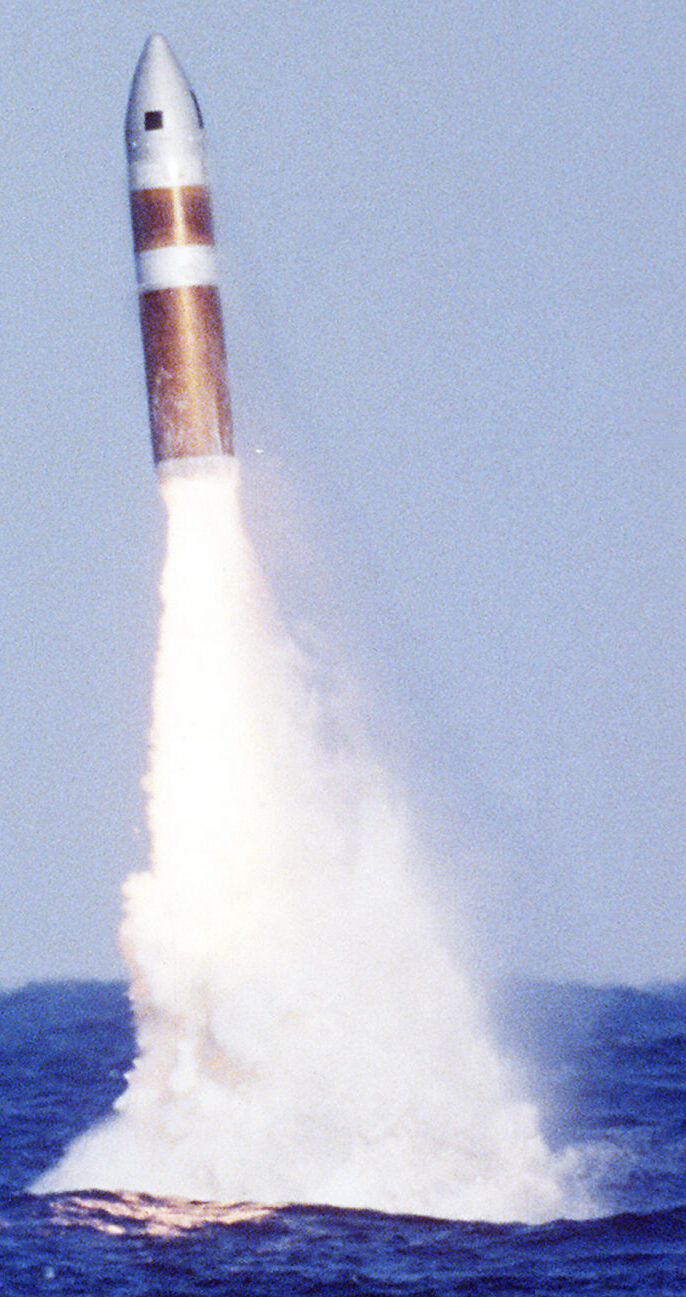
The UGM-73 Poseidon was a second generation USN nuclear-armed submarine-launched ballistic missile (SLBM) still with a two-stage solid-fuel rocket, replacing the UGM-27 Polaris from 1972 onwards, with advances in warheads and accuracy before replacement in 1979 by the Trident I and from 1990 by the Trident II.
A development study for a longer range Polaris was seemingly solved by enlarging it to the maximum possible size allowed by existing launch tubes. This process was initiated in 1963 just as the first Madison class SSBNs were launched. Tests with the larger Polaris A3 already showed that larger missiles could be launched from tubes having their fiberglass liners and locating rings removed.
The project became Polaris B3 in November but then renamed Poseidon C3 to emphasize the changes. The name inaugurated a new trend in ancient marine god, Poseidon being the equivalent of Neptune for the Greeks. The C3 was the only Poseidon variant ever produced as UGM-73A.
It was longer and considerably wider, heavier than the Polaris A3 but on the same 4,600 kilometres (2,500 nmi) range. It however had a greater payload capacity and much improved accuracy with a less than 500 m CEP. It had evern more independently targetable reentry vehicle (MIRV), up to ten or fourteen W68 thermonuclear warheads for lower yelds. With fourteen, it meant that each Madison class boat now had the potential to strike 224 targets at once, launching volleys at four missiles per minute, so a total of four minutes giving up its position.
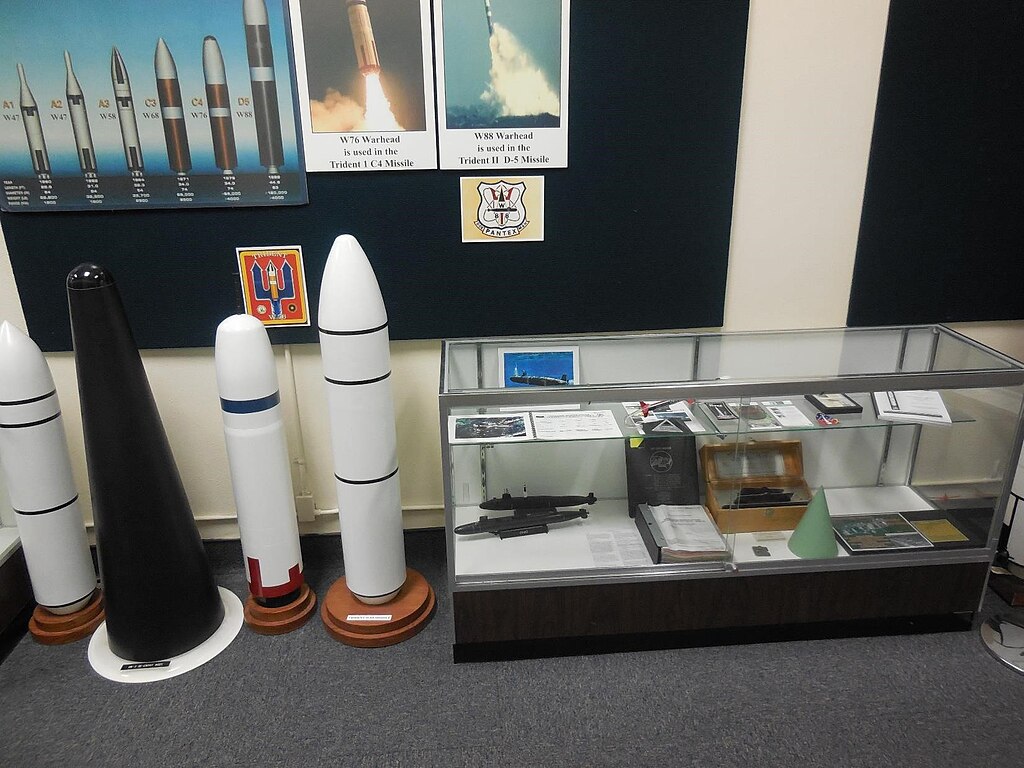
W68 MIRV (black) and other models shown alongside other systems at the US navy missile and rocket hallway.
The W68 warhead MIRV were low yeld (40 Kt or 170 TJ) and weighted each 367 pounds (166 kg). They were the smallest thermonuclear warheards ever built in the US and were intially designed by the Lawrence Livermore National Laboratory from 1970, produced until June 1975 and maintained in service until the end of the cold war in 1991. To put things in pespective 40 kilotonnes TNT was still twce as much as the Nagasaki bomb, 21 kt. It was enough to devastate a medium city or any large military installation port, airport, facory complex.
For the nitty-gritty, the Poseidon was still very much close to the Polaris with the same rocket motor, which was still in the submarine, considered very dangerous. It was ejected from its launch tube using high pressure steam from a solid-fueled boiler and the rocket motor ignited automatically at 10 metres (33 ft) above the submarine. The first test launch took place on 16 August 1968, and first at sea from USNS Observation Island and first from USS James Madison on 3 August 1970. It entered service officially on 31 March 1971 and equipped all 31 Lafayette/Madison/Franklin-classes. The Royal Navy considered adopting it for its Polaris A3T boats, keepin its Resolution class relevant. However instead the British government adopted Chevaline, a two warhead MIRV system with decoys, and after its failure, moved on to the Trident D5 in new SSBNs.
From 1979, 12 Poseidon SSBNs were refitted with Trident I (see below).
⚙ specifications Poseidon C3 |
|
| Weight | 64,400 pounds (29,200 kg) |
| Dimensions | 34.1 feet (10.4 m) x 74 inches (1.9 m) |
| Propulsion | 2-stage solid-fuel rocket, thrust vectoring |
| Speed | 8,000 mph (13,000 km/h) terminal phase |
| Range | 3,200 nautical miles (5,900 km) with 10 MIRV |
| Guidance | Inertial |
| Accuracy | 0.3 nautical miles (560 m) CEP |
| Payload | 10-14 W68 warheads 40 kt each |
Trident I SLBMs
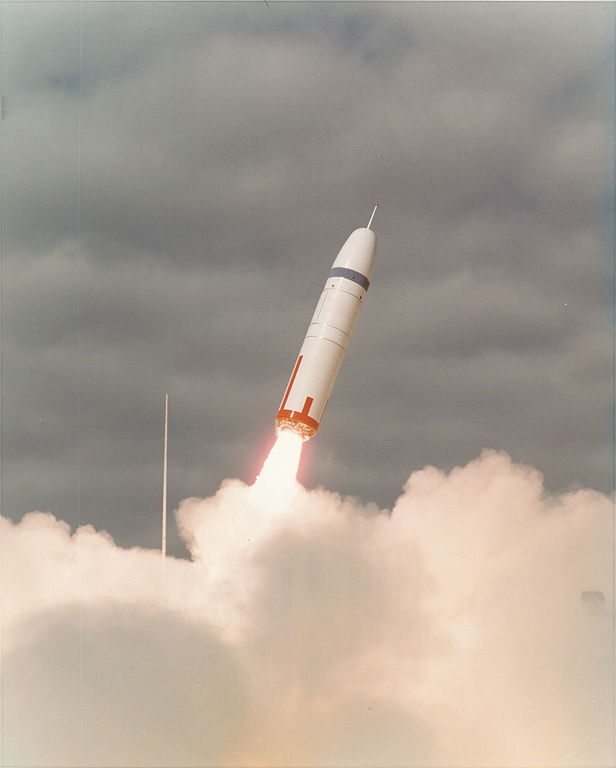
The Madison class was the first modified to fire and operate the Trident missile. Lockheed commenced work on the TRIDENT I (C4) as a program from November 1973, with an entry service planned for 1979 for the new Ohio-Class submarines authorized in 1974. Under the Extended Refit Program (ERP) the C3 (Madison) to C4 (Franklin) SSBN were to benefit a “backfit” program by mid-1976. SSBN 629, 630, and 634 had a “pierside backfit”, SSBN 627, 632, and 633 during their drydocked shipyard overhaul.
In 1971, studies for the Undersea Long-range Missile System (ULMS) concept led to the Decision Coordinating Paper (DCP) being approved on 14 September, for a long-term modernization plan and a longer-range missile termed ULMS II, with twice the range of the Poseidon (ULMS I). The other end of the program was its carrier, a much larger submarine to replace the Lafayette, Madison and Franklin-classes starting in 1978. The ULMS II was also designed to be retrofitted to existing SSBNs and the preimary payload of the future Ohio-class submarine.
In May 1972, the provisory term ULMS II was replaced by “Trident” to keep the tradition with ancient gods (as Neptune’s famous weapon). It was to have range capacity beyod 6,000 miles (9,700 km).
To put this into prespective, it could allow a SSBN in home waters off New England to fire any point west of the Ural on the Soviet territory, or from Attus island waters (Aleutian), any point on the Soviet territory with room to spare. The final Trident I however was capable of 4,600 nm which still allow to reach any point of the globe from international waters.
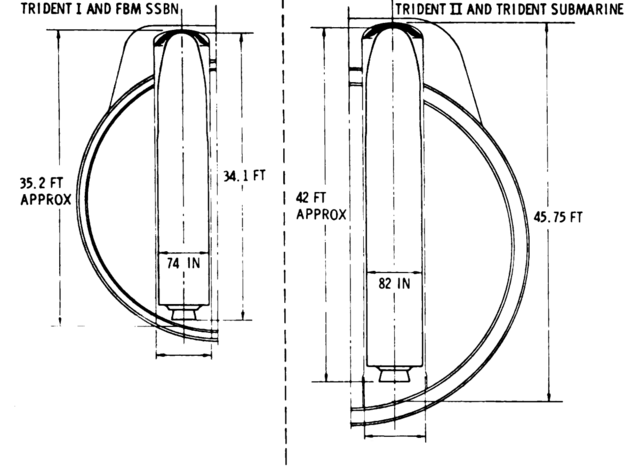
Growth potential: Trident I in a Madison/Franklin hull (left) and in an Ohio hull (right) with the longer Trident II.
The first test of the Trident was filmed on January 18, 1977 with an unarmed missile launched from Cape Canaveral, Florida, travelling 4,600 miles (7,400 km), into the setp point in the South Atlantic Ocean, near Ascension Island. The Trident I (C4) was first deployed in 1979, and retired in 2005. It was as fast as the Poseidon (C3) but with extended range. Next the Trident II (D5) was tasked to reduce its CEP, or accuracy, first deployed at the end of the cold war, in 1990 for a service planned until 2027.
Tridents were also delivered to UK under the terms of the 1963 Polaris Sales Agreement, modified in 1982 for Trident. Total cost of program went up to $39.546 billion in 2011, $70 million per missile. More to come with the Ohio class.
⚙ specifications UGM-96A Trident I |
|
| Weight | 73,066 pounds (33,142 kg) |
| Dimensions | 33 feet (10.2 m) x 71 inches (1.8 m) |
| Propulsion | 2-stage solid-fuel rocket, thrust vectoring |
| Speed | 20,000 ft/s (6,000 m/s), 13,600 mph (21,600 km/h) or Mach 18 terminal phase |
| Range | 4,600 nautical miles (7,400 km) with 8 W76 (100 kt) MIRV |
| Guidance | Auto-inertial |
| Accuracy | 229-500m CEP |
| Payload | 8 W79 warheads 100 kt each |
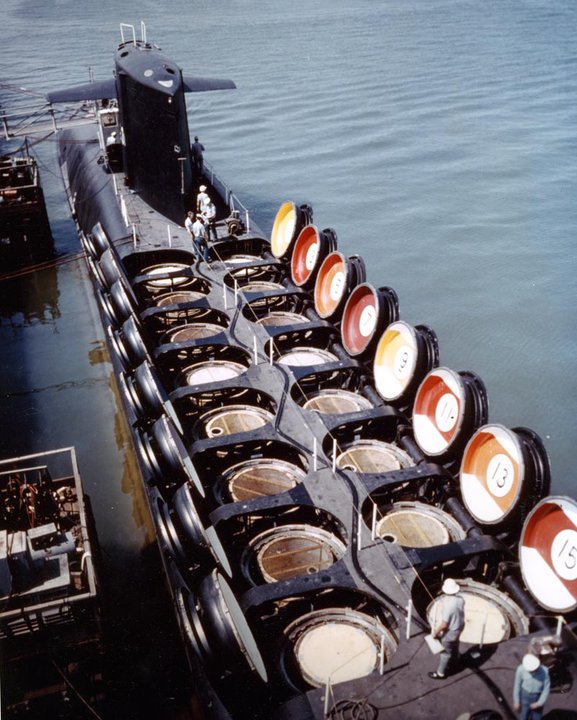
USS Rayburn showing her missile tubes open
Torpedo Tubes
Unlike the Washingtons and Ethan Allen and like the previous Lafayette class, only four torpedo tubes were kept, and these Mk 65 tubes were relocated to the sides forward amidships in angled tubes, to free the nose for the large sonar. Despite the fact they were not intended to be hunters, having the same very capable sonar meant they could keep a better underwater awareness of potential other adverse SSNs in the vicinity and act accordingly. They had modern torpedoes similar to those featured on the Sturgeon class, with as backup the alsways trusted Mark 16 Mod 6 torpedoes initially, a modernized version of a 1943 design, rugged and reliable. They had the more modern Mark 37 and the Mark 48 as mainstay for their 16 torpedoes reserve.
Sensors
The Madison class had a new suite: The BPS-11A radar, BQS-4A, BQR-7, BQR-15, BQR-19 and 21 sonars
BPS-11A radar
The AN/BPS-11A is a medium-range surface search and navigation radar searching in the X-band or I-band. Frequency 8 740 to 8 890 MHz, PRF 540 to 660 Hz
pulsewidth (τ) 0.5 µs at peak power 110 kW. Range 80 nm (148 km). Beamwidth 2.6°, up to 8 rpm rotation.
BQS-4A sonar
The BQS-4 was active sonar, here in its latest variant. The AN/BQS-4 is an active/passive detection sonar consisting in the AN/BQR-2 passive detection system and added active detection capability.
The BQS-4 active component comprised seven vertically stacked cylindrical transducers, located inside the BQR-2 chin bow dome to transmit its active “pings.”
In addition to passive listening, it can operate in either automatic echo-ranging or “single-ping” modes.
BQR-7 sonar
The AN/BQR-7 sonar is a long-range passive equipment installed on 594-class nuclear submarines. Target signals are recorded contiruously on a bearing-time-recorder display. A steered-beam audio display is also available for tracking one target at a time. The bearing of a particular target can be read from a dial on the operator’s console and the data can be transmitted automatically to the fire control system.
The hydrophones for the BQR-7 sonar are mounted in vertical staves, in groups of three, in a horseshoe configuration conforming to the shape of the submarine’s bow. There are 156 hydrophones
organized into 52 staves. Each stave has its individual amplifier for boosting the received signal. There are two independent compensator switches in the system. One compensator swit- feeds the BTR from the output of a continuously scanning beam rotated at a preset rate. The other switch, which is manually positioned, controls a narrow beam which presents the audio signal to the operator.
One compensator can automatically sweep and record target signals on the BTR while the other is used for manual search detection and tracking, The audio beam is trained in azimuth by a “steering wheel” control mounted on the console. The effectiveness of the BQR-7 passive sonar is reduced by own-ship noise during high-speed cruising. This apparently becomes critical over 5-6 knots.
The full description in a declassified document here
BQR-15 sonar
The AN/BQR-15 is a passive detection system including a thin line towed array (9080 line) coupled with the AN/BQR-23 signal processor. This array cable could be as long as 2,640 ft (800 m) long for a diameter of 0.5 in (12 mm). It is rolled down by a winch with hydraulic drive allowing the array to be streamed, retrieved or adjusted while submerged. It can be deployed in 15 minutes. This system was an upgrade in the late 1970s for the Ethan Allen class. It is part of the sonar suite carried by the the former SSBN-616 Lafayette class and current SSBN-726 Ohio class. More
BQR-19 sonar
Nicknamed “top hat”, this mast-mounted 1,000 pounds (454 kg) was an active, short-range and rapid-scanning submarine sonar for collision avoidance, navigation and other applications like upward-looking ice detection and mine detection. Its Initial operational capability (IOC) was attained in 1970 and it was deployed from the start on the OHIO-class submarines but also found its way on the upgraded Ethan Allen class.
BQR-21 sonar
Hull-mounted passive detection and tracking sonar, digital version of the BQR-2B with digital multibeam steering (DIMUS) coupled with the AN/BQR-24 signal processor and using both analog and digital processing techniques for a range of 100 miles (160 km) and tracking up to 5 targets simultaneously. Transducers were arranged in the bow conformal array, filling all available space as the torpeod tubes were relocated on the sides.

Conways profile of the Lafayette class, identical externally to the Madison apart the size of their silos
⚙ Madison class spec. |
|
| Displacement | 7,325 long tons (7,443 t), Submerged 8,251 long tons (8,383 t |
| Dimensions | 425 ft x 33 ft x 28 ft 6 in (130 x 10 x 8.69 m) |
| Propulsion | 1 shaft S5W PWR 2x geared steam turbines (15,000 shp (11,000 kW)) |
| Speed | 16 knots (30 km/h) surfaced, 21 knots (39 km/h) submerged |
| Range | Unlimited except by food supplies |
| Armament | 16 Polaris A3 missiles, later Poseidon, Trident, 4× 21-in (533 mm) TTs (12 torpedoes) |
| Sensors | BPS-11A radar, BQR-19 sonar |
| Test depth | 1,300 feet (400 m) |
| Crew | 2x 126 Blue/Gold (14 officers) |
Career of the James Madison class boats
 USS James Madison (SSBN-627)
USS James Madison (SSBN-627)
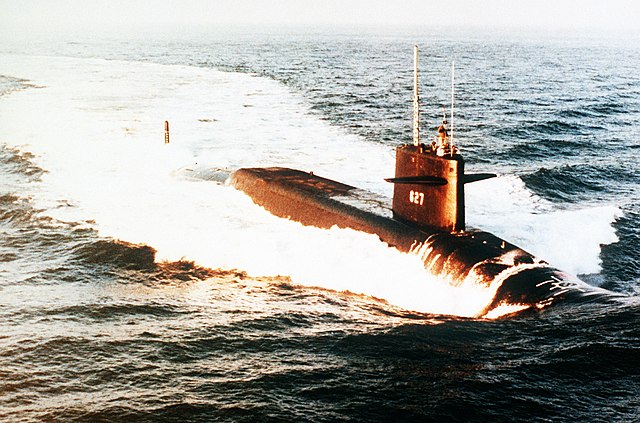
USS James Madison or SSBN-627 was laid down at Newport News Shipbuilding and Drydock Co. on 5 March 1962. She was launched on 15 March 1963 and completed on 28 July 1964.
After post-shakedown modification in November-December 1964, she made her first deterrent patrol on 17 January 1965 and had mad ten by the end of 1966, in the European area, Atlantic fleet and Scotland base. In November 1974 she had a collision with a Soviet Victor-class submarine as she was departing Holy Loch in Argyll, Scotland. The Soviet submarine just was waiting outside the port in order to trail her. Edinburgh marine historian Eric Graham told BBC Scotland this could have been a serious diplomatic incident as the Victor class was deep insife UK home waters and an “embarrassment” if local authorities wanted to keep it quiet. In any case, damage to USS Madison was light.
She soon had her first major overhaul, retrofitted to fire the Poseidon C-3 and the associated Mark 88 fire-control system. Later she had her second and last major overhaul in the early 1980s and adopted the Trident C-4 missile at Newport News Shipyard. She was inactivated at Mare Island, Vallejo, California, from 18 February 1992.
She was decommissioned and stricken the same day on 20 November 1992 at mare Island and disposed of through Ship-Submarine Recycling Program in Bremerton, Washington, completed on 24 October 1997.
 USS Tecumseh (SSBN-628)
USS Tecumseh (SSBN-628)
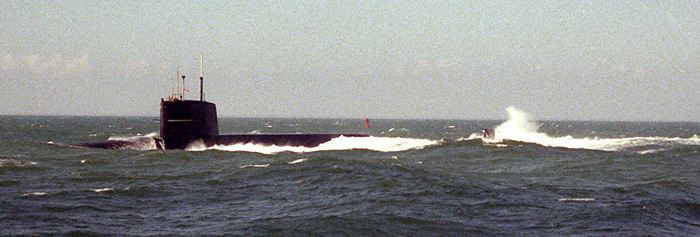
SSBN-628 was laid down at General Dynamics Electric Boat on 1 June 1962, launched on 22 June 1963 and completed on 29 May 1964. First SSBN named after an ancient Indian chief, she was Based at Pearl Harbor, Hawaii from the start, and started her first patrol from Mariana Islands on 17 December 1964, entering Guam’s Apra harbor on 29 December 1964 for her first deterrent patrols.
She had 21 patrols performed by 1969, when transferred to the United States Atlantic Fleet via Pearl Harbor and the Panama Canal, entering Newport News on 8 November 1969. There, she had her forst major overhaul and conversion to the Poseidon ballistic missile system, recommissioned on 9 May 1970. Her new home port became Charleston in South Carolina, from 18 February 1971.
After sea trials and shakedown she made two deterrent patrols by late 1971 and for the next ones was deployed from Holy Loch, arriving on 9 February 1972. She made 18 more deterrent patrols from there through 1976.
Homeported back to Charleston from March 1982 until she had her second major refueling overhaul in Newport News shipyard by late 1983 (and Trident upgrade), completed by the Spring of 1987 and completed sea trials, shakedown followed by a first missile launch and back to Charleston. From 1987 to 1992 from Charleston SC and alternatiovly from Holy Loch in Scotland she multiplied patrols. In 1992, she off-loaded her missiles and took part in war games off Charleston for Anti-Submarine warfare vessels or planes. By January 1993, she transited Panama to sail to Bremerton, Washington, decommissioned on 23 July 1993 and disposed of through Ship-Submarine Recycling Program in 1994.
 USS Daniel Boone (SSBN-629)
USS Daniel Boone (SSBN-629)
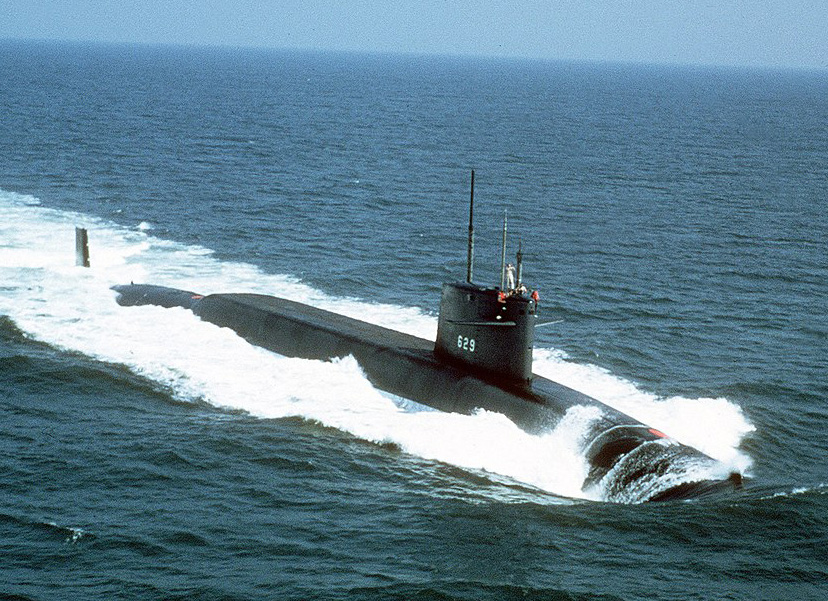
USS Daniel Boone or SSBN-629 was laid down at Mare Island Naval Shipyard on 6 February 1962, launched on 22 June 1963 and completed on 23 April 1964. She was upgraded to the Poseidon in her first major overhaul and Mark 88 fire-control system and the Trident C-4 in her second. On 6 September 1980, Boone became the first Madison class boat operational with it.
Daniel Boone had a last overhaul at Tenneco Shipyard, Newport News, by late 1985/early 1986 and during her post-refit sea trials on 7 April 1987 she ran aground in the James River when the Officer of the Deck trying to counter act tidal currents, lowered her Secondary Propulsion Motor, which snapped off on a sandbar. However it was about to be retracted, opening up an unpluggable 6 inches diameter hole in the hull. This was countermanded by watchstanders in the Machinery space which disobeyed direct orders but saved the boat. She needed some repairs still in Tenneco Shipyard’s dry dock. She performed her patrols in the Atlantic and from Holy Loch and was decommissioned on 18 February 1994 and disposed of through Ship-Submarine Recycling Program the same year.
 USS John C. Calhoun (SSBN-630)
USS John C. Calhoun (SSBN-630)

SSBN-630 was laid down at Newport News Shipbuilding and Drydock Co. on 4 June 1962, launched on 22 June 1963 and completed on 15 September 1964.
She srtarted her operational deterrent patrols on 22 March 1965, assigned to Submarine Squadron 18 and from 1979 to 1982, she was overhauled and upgraded to carry the Trident I ballistic missile.
She was decommissioned on 28 March 1994 and disposed of through Ship-Submarine Recycling Program. No data for her history published yet.
 USS Ulysses S. Grant (SSBN-631)
USS Ulysses S. Grant (SSBN-631)
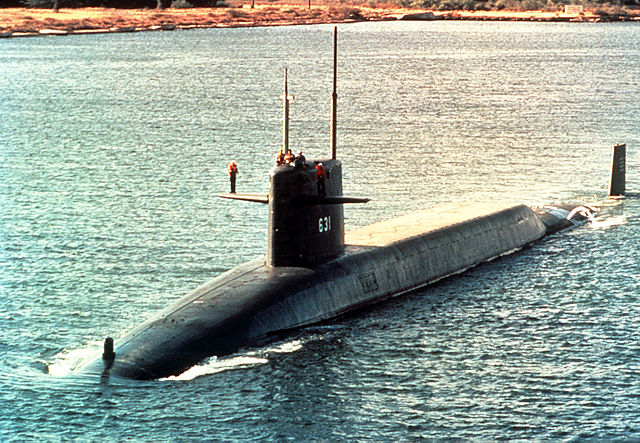
SSBN-631 was laid down at General Dynamics Electric Boat on 18 August 1962, launched on 2 November 1963 and completed in 17 July 1964. After shakedown, she left from Groton by early December 1964, for the Pacific Ocean via the Panama Canal on 31 December and arriving at Pearl Harbor in January 1965. Mirroring the forward deployment from the Holy Loch in the Atlantic, she was forward deployed to Guam, Mariana Islands for her first 18 deterrent patrols with the Polaris A3. From late 1969 she had an overhaul and conversion to the Poseidon at Puget Sound, Bremerton, Washington. She was then redeployed to the Atlantic and Holy Loch from 1970, operating from there until September 1977.
Next she had her second major refueling overhaul at Portsmouth in Kittery, Maine. Blue Crew (Captain W.G. Ellis) performed at that time “The best DASO (Demonstration and Shakedown Operation) in 10 years,”, firing a test missile on 31 July 1980. Ulysses S. Grant was homeported back to Charleston and gree the Gold Crew, under Commander Michael P. McBride making a second DASO, granted later a swim call in the Caribbean. Her regular operating base remained Holy Loch until 1984.
By 7 April 1987, two crewmen were swept off her missile while in heavy seas 3 miles off Portsmouth. Lt. David Jimenez was rescued but pronounced dead and Chief Torpedoman’s Mate Larry Thompson remained “lost at sea”.
In 1989, Blue Crew took over whill alongside the submarine tender USS Fulton, and sailed to Holy Loch, for the last deterrent patrols of her career.
She was decommissoned on 12 June 1992 and disposed of through Ship-Submarine Recycling Program in 1992.
 USS Von Steuben (SSBN-632)
USS Von Steuben (SSBN-632)
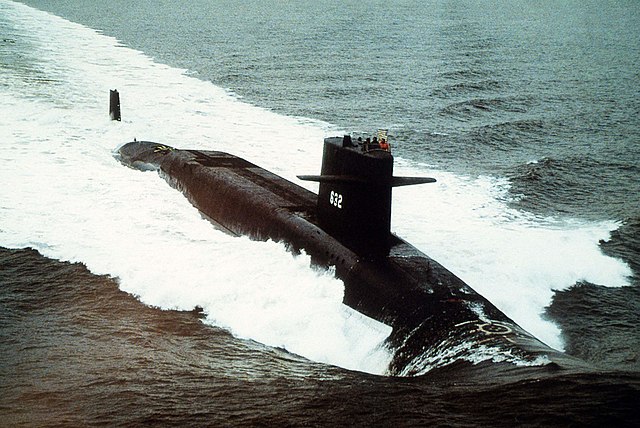
SSBN-632 was laid down at Newport News Shipbuilding and Drydock Co. on 4 September 1962, launched on 18 October 1963 and completed on 30 September 1964 under Commander John P. Wise (Blue Crew) and Commander Jeffrey C. Metzel (Gold Crew). In the autumn of 1964, she made two shakedown cruises for its crews with intermediate ASW exercises, and by 22 December 1964, Gold Crew fired her first Polaris A3 in the Atlantic Missile Range. In 1965 Blue crew did the same off off Cape Canaveral, Florida. In February 1965 fully qualified she was sent to HP Newport News to start a cycle of deterrent patrols.
In March 1965, Von Steuben was assigned to Submarine Squadron 18 at Charleston and completed her 11th deterrent patrol by early in 1968, before being reassigned to Submarine Squadron 16, out of Rota, Spain until mid-1969. But on August 9, 1968, while osubmerged 40 miles off the southern coast of Spain she caught a tug submerged tow cable, towing the merchant tanker “Sealady” former liberty Bengt H. Larsonn now Alan Seeger (1954)). As she was under tow her propellers and engines were shut and she could not be detected while precisely at this momment, the SSBN lost depth control and steering, making an emergency main ballast tank blow and colliding with the towed ship. here was substantial external damage to the sail and superstructure and she had local repairs at Rota, before departing for Groton for detailed repairs at Electric Boat Division before returning to Rota. The incident trigerred the use of magnetic animaly detectors before such manoeuvers; but this was ,ot always efficient or applied:
USS Greeneville on 9 February 2001 did the same off Oahu while hosting civilians and bumped into the 191-foot (58 m) Japanese fishery high school training ship Ehime Maru. Lifted off she broke in two and sank in less than ten minutes, with nine crew members and four high school students. Her planes tangled in her submerged towline and jammed them. The captain later faced a court of inquiry and his request to retire was approved.
In November 1970, Von Steuben sailed to Groton for a 16-month overhaul and fitting the Poseidon C-3, followed by post-conversion shakedown in 1971 and, escorted by USS William C. Lawe (DD-763), making a two-missile fire or DASO in February-March 1971.
In May she was back to Charleston and resumed deterrent patrols with an extended Refit at Portsmouth NyD in March-May 1978. Her ballistic missile system was upgraded for the Trident I in the early 1980s, later retrofitted to 11 other Madison and Franklin classes. She was the first. She resumed strategic deterrent patrols until decommissioned on 26 February 1994 and disposed of through Ship-Submarine Recycling Program, 2001.
 USS Casimir Pulaski (SSBN-633)
USS Casimir Pulaski (SSBN-633)
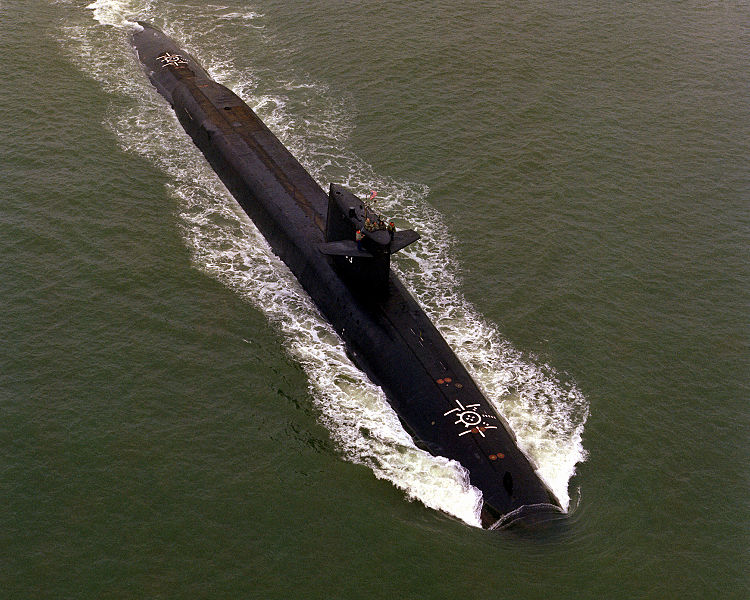
SSBN-633 was laid down at General Dynamics Electric Boat on 12 January 1963, launched on 1 February 1964 and completed on 14 August 1964. She made a three-month shakedown cruise with both crews off Cape Kennedy, firing her Polaris missiles on 31 October and 13 November 1964 respectively, until fully qualified after fixed in December at Groton. She then moved to the Polaris Missile Facility Atlantic at Naval Weapons Station Charleston for load out and assigned to Subron 16 Atlatic fleet, souther sector, operating not from Scotland by from Naval Station Rota in Spain from March 1965. She performed 20 deterrent patrols, before her first core refualling and overhail in Groton from 5 January 1970, her S5W reactor being replaced by a S3G core 3, the 7th SSBN refitted with the Poseidon. After which she was reassigned to SubRon 14, northern Atlantic sector from Holy Loch on 30 April 1971.
By June 1971, while there she was the first to receive and test the Integrated Data Acquisition System (IDAS) M-35. On 2 July Blue Crew made her first Poseidon launch in DASO to collect and analyse flight data. Gold Crew did the same on 16 August and she later performed her first patrol on 28 October 1971. She made her sixth launch under Gold Crew, four misssile on 2 March 1973.
In July 1974, SubRon 14 staff awared her a Battle “E” Award, first ever for any SSBN. She later celebrated her 50th strategic deterrent patrol.
By Late 1980, she had her last upgrade and refuelling overhaul at Newport News Shipyard, one of the first to receive the UGM-96 Trident I and joining Subron 16, at the sub base Kings Bay, from 10 December 1982. She performed her DASO on 19 April 1983 with Gold Crew with a Trident I launched which flight was terminated due to a malfunction. She made her first Trident patrol from 3 June.
On 17 June 1985, she fired four Trident I at the Atlantic Test Range Range, Cape Canaveral.
In October 1985, Gold Crew won the Arleigh Burke Fleet trophy from best combat efficiency of any Atlantic Fleet SSBN FY1985 under Command of Conrad A. Plyler, Jr. She also won the FY1986 Battle Efficiency “E” for SubRon 16 and the Fleet Ballistic Submarine Superior Performance Award Trophy (“Providence Plantation Trophy”), Atlantic Fleet under Commander Plyler (Gold Crew) and Commander William W. Schmidt (Blue Crew)as well as a Navy Unit Meritorious Commendation ribbon for 1985-1986.
From 1 April to 20 May 1989, USS Casimir Pulaski took part in the Exercise LANTCOOPEX 1-89 off Port Canaveral after which both crews received a Letter of Commendation from Secretary of the Navy, Henry L. Garrett III. She won also the FY1989 Battle “E” Award. In November also Blue Crew won the Humanitarian Service Medal for their actions after Hurricane Hugo in the Caribbean and SE US.
In May 1993, Pulaski performed her 88th, final deterrent patrol and she was transferred to the Pacific Fleet for inactivation, earning the record for the “41 For Freedom” submarine fleet.
She was decommissioned on 7 March 1994, disposed of through Ship-Submarine Recycling Program.
 USS Stonewall Jackson (SSBN-634)
USS Stonewall Jackson (SSBN-634)
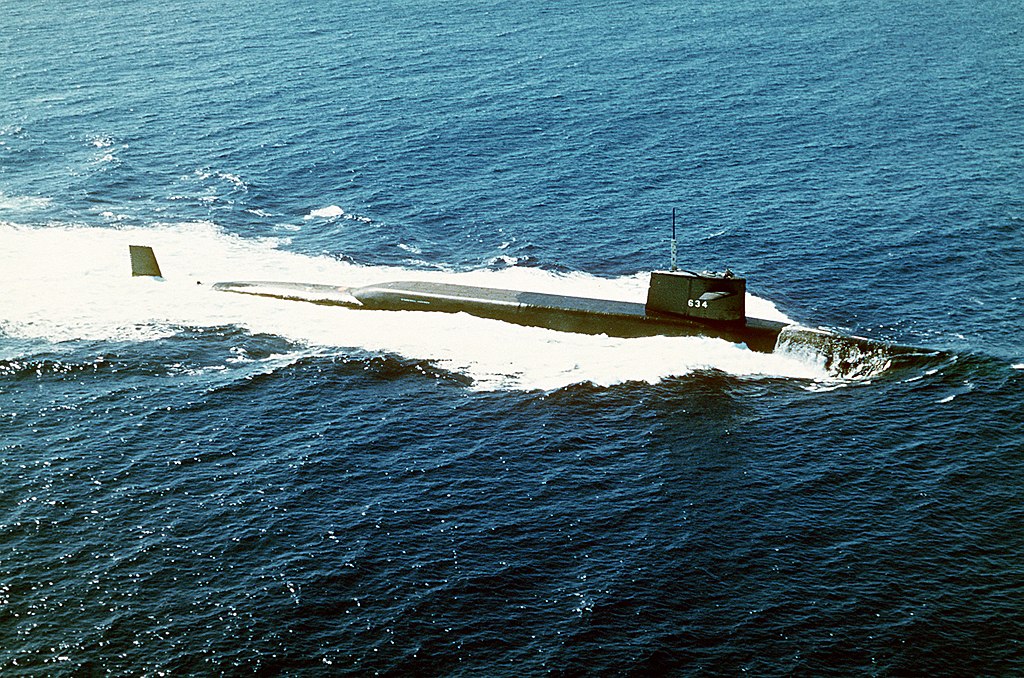
SSBN-634 was laid down at Mare Island Naval Shipyard on 4 July 1962, launched on 30 November 1963 and completed on 26 August 1964 with Commander John H. Nicholson (Blue Crew) and Commander Richard A. Frost (Gold Crew). She departed Vallejo on 3 September 1964 for her shakedown cruise, eastwards via Panama to Cape Kennedy in Florida. Blue Crew completed training with a Polaris launch on 2 December 1964 and and Gold Crew on 16 December 1964. She returned to the Pacific for post-shakedown operations wit fixes until 13 February 1965 and preparations for patrols at Bangor. Sje commanced her first patrol from April 1965. By June 1965, she was based at Apra Harbor, Guam and made aptrols from there for five years.
By the spring of 1970, Stonewall Jackson was reassigned to the Atlantic Fleet and left Pearl Harbor on 23 April 1970, for a special operation, and then crossed the Panama Canal on 7 May until joining SubFlot 6, Atlantic Fleet. On 15 May she was based at New London.
After upkeep she sailed to Annapolid on 1 June and from the 7th June to 10th she made midshipman cruises and afterwards, special operations. Sher was in Charleston, off-loaded her ballistic missiles in July then sailed for New London on the 10th and 5 days later, was overhauled and converted to the Poseidon at Electric Boat Division of General Dynamics at Groton until 29 October 1971. Between October 1971 and March 1972 Blue and Gold Crews had their shakedown cruises and fixes at Groton. On 7 April she loaded her missiles at Charleston and departed for her first Atlantic deterrent patrol, based at Holy Loch, Scotland until mid-1978.
She had her last extensive overhaul at Portsmouth, conversion for the Trident C-4 at Port Canaveral by late 1988. In 1988-1990 she was based in Charleston and deployed for patrols, then from Base Kings Bay in Georgia, until 1994. She was decommissioned on 9 February 1995 and disposed of through Ship-Submarine Recycling Program.
 USS Sam Rayburn (SSBN-635)
USS Sam Rayburn (SSBN-635)
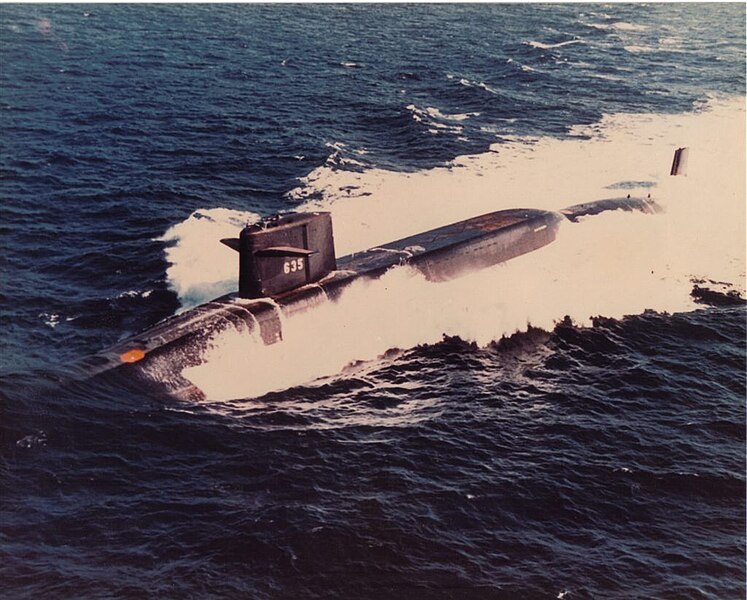
SSBN-635 was laid down at Newport News Shipbuilding and Drydock Co., launched 3 December 1962, launched on 20 December 1963, and completed on 2 December 1964 with Captain Oliver H. Perry, Jr. (Blue Crew) and Commander William A. Williams III (Gold Crew). She made a demonstration and shakedown at the Atlantic Missile Range, first Blue Crew and then Gold Crew and after qualif. and loading missiles, joined SubRon 18 at Charleston, starting her first patrol by the summer of 1965. In August she started operations from Rota, and the Charleston from December 1966. In 1967 USS Sam Rayburn completed her 11th patrols and 14th in 1968.
In December 1969, she had an overhaul at Portsmouth until 27 May 1971, remaining on the East Coast until 1972. Next based in Charleston she started special operations. She multipled deterrent patrols but on 10 June 1985, the U.S. Navy announced plans to dismantle the class with SALT II trying to limit MIRVs.
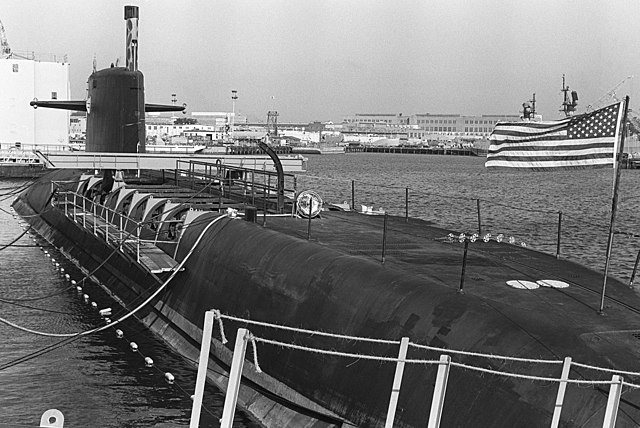
She was selected and deactivated on 16 September 1985, her tubes filled with concrete, hatches removed. The whole compartment was later dismantled, bow and stern pulled together, welded in place so she became a shorter “SSN training ship”.
She was decommissioned on 31 July 1989 and converted to the Moored Training Ship (MTS-635) and stricken from the Naval Vessel Register on 31 July 1989. She was sent to the Naval Nuclear Prototype Training Unit at Goose Creek in South Carolina and achieve criticality by August 1989. She had special mooring arrangements and a Water Brake, as well as a gear governor for her main propulsion shaft. She remained a moored training ship from 1989 to 2021, the last if her class still in existence. MTS-635 departed the Unit on 1 April, towed to Norfolk on 3 April for full defueling and dismantling. She was replaced at the unit by USS La Jolla (SSN-701) and USS San Francisco (SSN-711).
 USS Nathanael Greene (SSBN-636)
USS Nathanael Greene (SSBN-636)
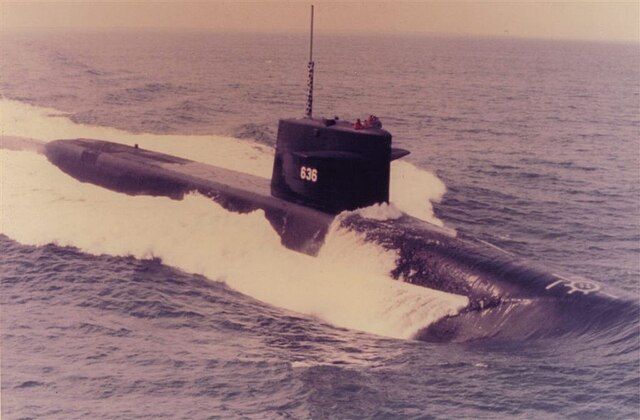
SSBN-636 was laid down at Portsmouth Naval Shipyard on 21 May 1962, launched on 12 May 1964 and completed on 19 December 1964 with Commander Robert E. Crispin (Blue) and Commander William M. Cossaboom (Gold). She departed Portsmouth for shakedown on 30 December 1964 (Gold), relieved on 1 February 1965 by the Blue Crew and after repairs and alterations at Portsmouth she departed for ballistic missile loading and first deterrent patrol. In 1970-1971 she was refueled and upgraded to the Poseidon at Newport News. She tested these at Cape Canaveral and on March 1972 made her first Poseidon deterrent patrol from Holy Loch.
On January 29, 1970, while underway thick fog, she ran aground in 16 feet of water but was refloated after 7 hours. On August 11, 1984, she lost her propeller in the Irish Sea while underway to Holy Loch. She was sailing at 3 knots on her secondary propulsion motor when redirected to Clyde base at Faslane as Holy Loch was Yard unavailable. While she was in Admiralty Floating Dock No. 60 at Faslane a fire broke nearby in a nearvy machinery space on 18 August 1984, quickly extinguished. When axamined it was concluded her main shaft had broken and lost 1/3 its length and the propeller. Repairs took 12 days until 3 September.
On 13 March 1986 she ran aground in the Irish Sea, with severe damage to her rudder and ballast tanks, and so far the most serious accident of any SSBN. She was deactivated by May 1987, after examination of the extensive damage and in accordance with the SALT II treaty limitations, decommissioned on 15 December 1986 and disposed of through Ship-Submarine Recycling Program in 2000.
Read More/Src
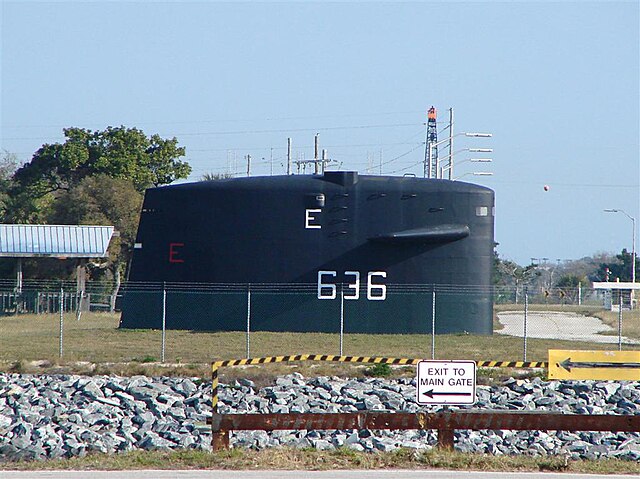
The preserved sail of USS Nathanael Greene as of today.
Links
navsource.org/
nuke.fas.org/
airandspace.si.edu/ polaris-3
spaceline.org/ lafayette-class-submarines/
nuclearcompanion.com polaris-a-3
nuke.fas.org ssbn-secure
https://en.wikipedia.org/wiki/UGM-96_Trident_I

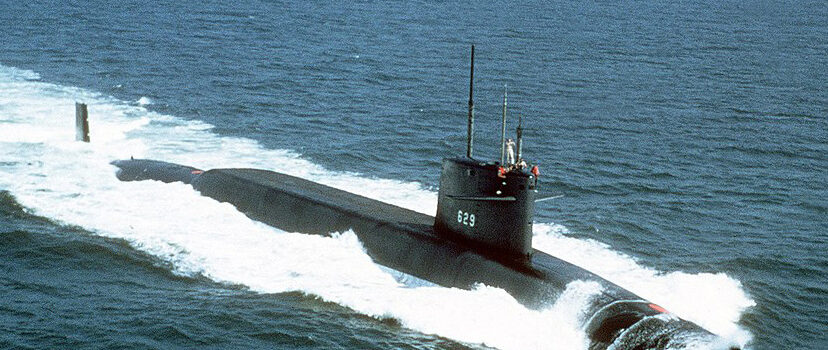
 Latest Facebook Entry -
Latest Facebook Entry -  X(Tweeter) Naval Encyclopedia's deck archive
X(Tweeter) Naval Encyclopedia's deck archive Instagram (@navalencyc)
Instagram (@navalencyc)





 French Navy
French Navy Royal Navy
Royal Navy Russian Navy
Russian Navy Armada Espanola
Armada Espanola Austrian Navy
Austrian Navy K.u.K. Kriegsmarine
K.u.K. Kriegsmarine Dansk Marine
Dansk Marine Nautiko Hellenon
Nautiko Hellenon Koninklije Marine 1870
Koninklije Marine 1870 Marinha do Brasil
Marinha do Brasil Osmanlı Donanması
Osmanlı Donanması Marina Do Peru
Marina Do Peru Marinha do Portugal
Marinha do Portugal Regia Marina 1870
Regia Marina 1870 Nihhon Kaigun 1870
Nihhon Kaigun 1870 Preußische Marine 1870
Preußische Marine 1870 Russkiy Flot 1870
Russkiy Flot 1870 Svenska marinen
Svenska marinen Søværnet
Søværnet Union Navy
Union Navy Confederate Navy
Confederate Navy Armada de Argentina
Armada de Argentina Imperial Chinese Navy
Imperial Chinese Navy Marinha do Portugal
Marinha do Portugal Mexico
Mexico Kaiserliche Marine
Kaiserliche Marine 1898 US Navy
1898 US Navy Sovietskiy Flot
Sovietskiy Flot Royal Canadian Navy
Royal Canadian Navy Royal Australian Navy
Royal Australian Navy RNZN Fleet
RNZN Fleet Chinese Navy 1937
Chinese Navy 1937 Kriegsmarine
Kriegsmarine Chilean Navy
Chilean Navy Danish Navy
Danish Navy Finnish Navy
Finnish Navy Hellenic Navy
Hellenic Navy Polish Navy
Polish Navy Romanian Navy
Romanian Navy Turkish Navy
Turkish Navy Royal Yugoslav Navy
Royal Yugoslav Navy Royal Thai Navy
Royal Thai Navy Minor Navies
Minor Navies Albania
Albania Austria
Austria Belgium
Belgium Columbia
Columbia Costa Rica
Costa Rica Cuba
Cuba Czechoslovakia
Czechoslovakia Dominican Republic
Dominican Republic Haiti
Haiti Hungary
Hungary Honduras
Honduras Estonia
Estonia Iceland
Iceland Eire
Eire Equador
Equador Iran
Iran Iraq
Iraq Latvia
Latvia Liberia
Liberia Lithuania
Lithuania Mandchukuo
Mandchukuo Morocco
Morocco Nicaragua
Nicaragua Persia
Persia San Salvador
San Salvador Sarawak
Sarawak Uruguay
Uruguay Venezuela
Venezuela Zanzibar
Zanzibar Warsaw Pact Navies
Warsaw Pact Navies Bulgaria
Bulgaria Hungary
Hungary

 Bundesmarine
Bundesmarine Dutch Navy
Dutch Navy Hellenic Navy
Hellenic Navy Marina Militare
Marina Militare Yugoslav Navy
Yugoslav Navy Chinese Navy
Chinese Navy Indian Navy
Indian Navy Indonesian Navy
Indonesian Navy JMSDF
JMSDF North Korean Navy
North Korean Navy Pakistani Navy
Pakistani Navy Philippines Navy
Philippines Navy ROKN
ROKN Rep. of Singapore Navy
Rep. of Singapore Navy Taiwanese Navy
Taiwanese Navy IDF Navy
IDF Navy Saudi Navy
Saudi Navy Royal New Zealand Navy
Royal New Zealand Navy Egyptian Navy
Egyptian Navy South African Navy
South African Navy






























 Ukrainian Navy
Ukrainian Navy dbodesign
dbodesign